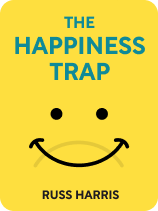

This article is an excerpt from the Shortform book guide to "The Happiness Trap" by Russ Harris. Shortform has the world's best summaries and analyses of books you should be reading.
Like this article? Sign up for a free trial here .
What is Russ Harris’s The Happiness Trap about? What is the key message to take away from the book?
In his book The Happiness Trap, therapist and life coach Russ Harris advocates for ACT, or Acceptance and Commitment Therapy, as a tool for getting ourselves out of “the happiness trap” and learning to deal with the pain and suffering in a productive way. Unlike CBT (cognitive-behavioral therapy), which focuses on changing your thoughts to lessen suffering, ACT teaches awareness and acceptance of negative thoughts and feelings.
Let’s explore the key ideas discussed in the book.
Humans Aren’t Naturally Happy
In his book The Happiness Trap, Harris explains that we have many misguided beliefs about happiness. These widely held beliefs trap us in vicious cycles that actually increase—rather than decrease—our suffering. The primary myth is that everyone can and should be happy.
Harris points out that we regard happiness as the most desirable human state. The pursuit of happiness is even enshrined as a fundamental human right, alongside life and liberty, in the US Declaration of Independence. Media and the internet bombard us with images of people who are beautiful, intelligent, and wealthy—and presumably happy. We envy them and believe we should strive to be like them. (Shortform note: Many companies also sell happiness by promising their products will make you happy. The late Zappos CEO Tony Hsieh wrote a 2010 book, Delivering Happiness, in which he argued that the way to build a successful business, and to be happy yourself, is to take extraordinary steps to make your employees and customers happy.)
While we expect to be consistently happy, Harris contends that our minds weren’t designed to work that way. He notes that the human brain has evolved with three traits that primitive humans needed to survive:
- The ability to detect threats and avoid them.
- The ability to fit into a group. A primitive human couldn’t afford to be kicked out and left to fend for himself.
- An accumulate-and-improve mentality. A primitive human needed to accumulate enough food to last his clan through lean times.
These traits have persisted on the evolutionary time scale, Harris notes that they have become dysfunctional because:
1. We no longer need threat detection and avoidance to protect us from predators in the wild. Instead, this instinct makes us detect imaginary threats, such as the possibility that we’ll never get married, or that a random ache is a symptom of a serious disease.
2. The ability to fit in is no longer the deciding factor in whether we starve to death, but we still compare ourselves to others and worry about whether we are normal. In the world of social media, where everybody is pushing an idealized version of themselves, this part of our brain looks at others and makes us worry that we compare unfavorably.
3. Our ability to accumulate and improve no longer determines whether we live or die. Still, our brains drive us to constantly accumulate more wealth, status, and happiness and to improve our lives as much as possible—but even when we accomplish these goals and improve our lives, the satisfaction doesn’t last long. So we quickly return to the cycle of accumulation and try to get even more.
Because our minds naturally supply us with a constant stream of threats, worries, and concerns that don’t actually contribute to our survival, Harris argues the natural state for humans is psychological discomfort rather than happiness. (Shortform note: Studies of brain activity show that we have a “negativity bias”—our brains respond more to negative images than to positive or neutral images. ACT founder Steven C. Hayes identified five ways our brains fixate on the negative: imagining dangers, ruminating about the past, worrying about what others think, feeling not good enough, and always needing more.)
Principle #1: Connecting With the Observing Self
Now that we’ve discussed how we get stuck in the happiness trap, we’ll explain how to escape it through ACT’s six principles of psychological flexibility, the ability to respond productively to negative thoughts and situations in order to build a rich and meaningful life.
ACT’s first principle is connecting with the observing self. (Shortform note: In the book and in ACT literature, this is listed as the fourth of the six principles. However, we’ve chosen to examine it first because it provides helpful context for understanding the other principles.)
The Thinking Self Thinks, the Observing Self Observes
According to ACT, our minds encompass a thinking self and an observing self. Harris argues that the thinking self and the observing self are different faculties: The thinking self provides a judgmental running commentary on events, while the observing self neutrally observes this commentary.
While the thinking self thinks, judges, and acts, the observing self is a kind of “meta-awareness.” Your observing self notices everything you experience—your thoughts, physical sensations, and the world around you.
When you understand the relationship between the thinking self and the observing self, you can redirect the observing self’s attention away from the thinking self and toward other sources of input, like your five senses. This ability to redirect your attention is the foundation for mindfulness techniques that can alter the way you experience everything.
| Self-as-Context ACT literature refers to the observing self as “self-as-context”—the alternative to the “conceptualized self,” or the person we think we are because of the running commentary of the thinking self. This terminology makes the concept of the observing self a bit more clear—in the self-as-context model, our thoughts, feelings, and experiences occur within the context of the self, rather than being identified with the self. Imagine the self-as-context as a playground and the individual thoughts, feelings, and experiences as children who are playing on the playground. Even when all of the children have gone home, the playground will still be a playground. It would be nonsensical to argue that the children are the playground—they often populate the playground, but they don’t define it. |
Principle #2: Defusion
When you mistake what your thinking self thinks for reality, ACT says you’re in a state of “fusion” with your thoughts.
Harris explains that the antidote to fusion is defusion, or separating ourselves from our thoughts. Rather than taking our thoughts as the absolute truth, through defusion, we harness the power of the observing self to take a step back and recognize them as stories our brain tells us to help us survive.
When we practice defusion:
- We recognize that our thoughts are merely words and images, not reality. For instance, if we make a mistake at work, we recognize that our mind’s reaction (“I’m an idiot”) is simply a story produced by our brain rather than an objective fact.
- We believe that our thoughts only have significance if we judge them as useful to us.
- We don’t believe we should do what our thoughts tell us to do, or that we have any obligation to those thoughts beyond acknowledging they exist.
- We don’t experience negative thoughts and images as threats, because we understand that they’re only words and pictures. Accordingly, there’s no need to eliminate negative thoughts.
By practicing defusion and accepting your negative thoughts, Harris says, you live a richer life and experience the world more fully—rather than continually trying to eliminate negative thoughts and feelings.
| Common Hurdles in Defusion Clinical psychologist and ACT trainer John T. Blackledge identifies common problems that people can experience when trying to apply defusion to their lives. The idea of defusion can be a tough pill to swallow when we struggle with long-term, persistent negative thoughts: Fusion causes us to believe these thoughts are facts, so when someone tells us to defuse from such a thought, it feels like they’re saying we can’t reliably interpret our own reality. The idea of defusion, taken to an extreme, can lead to a sense of meaninglessness. If thoughts are just thoughts, then what about the important thoughts that we have concerning our morals and ethics? When we practice defusion, it can be difficult to separate our factual thoughts from our nonfactual thoughts. Some factual thoughts are clear (like “This is made of steel”), but sometimes it’s unclear whether a thought is factual (and therefore useful to you, even if it makes you feel bad). |
Principle #3: Expansion
The third principle of ACT—expansion—does for the feelings and urges of our physical body what defusion does for the thoughts and images of our thinking self. We use our observing self to create space for the negative feelings and urges in our bodies, allowing us to stop struggling with our emotions and instead focus on acting to improve our lives.
Expansion: A Four-Step Process
Harris identifies four steps for using expansion to accept your emotions:
Step 1: Use your observing self to connect with the sensations in your body.
Take a few moments and notice the sensations or discomfort in each area of your body. We register emotions as physical sensations, so essentially, you’re scanning your body for negative emotions so that you can respond to them.
Focus on the least comfortable physical sensation. Notice its dimensions: Is it large or small? Uniform or irregular? How deeply do you feel the sensation? If you can, visualize this sensation as a distinct object with its own material and properties.
Step 2: Use deep breathing to explore the sensation.
As you scan the uncomfortable sensation, focus on breathing deeply. Your deep breathing should decrease the tension in your body. As your tension decreases, imagine your deep breath forming an eggshell-like shelter around the discomfort.
Step 3: Make additional room in your body for the sensation.
Imagine that eggshell growing until your body can freely accommodate the discomfort. Rather than feeling that the sensation is trapped in your body, causing disruption and tension, feel that it has room to move and grow, because your breathing can accommodate it.
Step 4: Tolerate the sensation, and give it space to exist.
Accept the emotion, rather than listening to your thinking self, which might be saying that the emotion is a threat (and therefore something you need to eliminate).
| The Physiological Effects of Deep Breathing Meditation exercises like this help release tension in our bodies and process emotions that we can’t simply “reason” our way out of. But just how does it work? Research has shown that specific emotions have different kinds of breathing associated with them. For instance, an emotion like joy involves deep, slow breathing, while an emotion like anger involves rapid, shallow breath. The deep breathing we practice in expansion is associated with calmness and joy. Thus, the feeling of release from emotional discomfort may be our body’s physiological response to deep breathing, rather than a mental and emotional response to the imaginative labor of “building an eggshell” around the sensation. Additionally, slow, deep breathing slows your heart rate and stimulates the vagus nerve, which is associated with your body’s recuperative processes, such as sleep and digestion. |
Principle #4: Connection
The fourth principle of ACT—connection—is the technique of using your observing self to connect to the external world through your five senses. Often, despite what’s going on around us, we’re focused on the world of the thinking self: our memories, our plans, our judgments. The thinking self focuses on the past and the future.
Harris writes that connection is the practice of using our observing self to shift our attention away from the past and future in order to be fully engaged in the present moment.
Harris lists three reasons to practice connection:
- We have only one life, and it’s relatively short. If the choice is between living in the moment and living outside of it, most of us would choose the first.
- In order to shape the kind of life we want, we must act—and the only time we have to act is in the present.
- Only awareness of the present moment allows us to take effective action—that is, action that aligns with our values.
(Shortform note: In addition to the benefits that Harris lists, research shows that connection—or mindfulness—strengthens relationships, makes stress more manageable, and improves symptoms of anxiety and depression.)
Achieving connection requires the techniques discussed in the previous principles, because when our thinking self obsesses over negative thoughts and feelings, we tend to disconnect from the present. Therefore, in order to achieve connection consistently, we need to practice defusion from our negative thoughts and expansion to accept our unwanted feelings.
| Presence as the Means vs. the End Eckhart Tolle’s The Power of Now focuses on the idea of connecting to the present moment as the solution to the problems of the ego (what Harris would call the thinking self) and the pain-body (the sum total of negative emotions that you carry). In contrast to Harris’s view that connection is one of many tools to help us live in alignment with our values, Tolle argues that being connected with the present moment can serve as a sole solution for the problem of suffering. Still, both Tolle’s and Harris agree that: -The thinking self (or ego) is a huge problem for most people. -The thinking self is predominantly concerned with the past and the future instead of the present moment. Harnessing our observing self (what Tolle calls “the inner body”) connects us to the present moment. |
Mindfulness: The “Acceptance” in ACT
The first four principles form the foundation of the concept of “acceptance” in Acceptance and Commitment Therapy. Taken together, they constitute a foundation that Harris calls mindfulness.
(Shortform note: Mindfulness isn’t unique to ACT. You can find it in many ancient Eastern traditions and religions, such as yoga, Buddhism, and meditation.)
Harris explains that in the context of ACT, mindfulness is a psychological state of openness and awareness attainable through consistent practice of mindfulness skills (such as defusion, expansion, and connection).
But attaining this state is not an end unto itself—instead, ACT advocates practical application, or applying behaviors to develop a valuable and enriching life. In other words, mindfulness is a practical skill (or set of skills) for improving your life in the real world.
(Shortform note: The assertion that acceptance is a means to improving your life addresses the common misconception that accepting a negative situation means “giving up” or condoning harmful behavior. In actuality, accepting the reality of a situation is the first step toward developing healthier ways to respond to or change it.)
Principle #5: Clarifying Values
In this section, we’ll explain how to use mindfulness skills to apply the fifth principle of ACT: clarifying your values. Values are the principles that govern how you want to act. Harris writes that, by clarifying your values, you set yourself up for the final step in the ACT process: committed action, or living in alignment with your values.
Harris explains that values are:
- Continuous—unlike goals, they cannot be completed.
- Action-oriented—they concern how you want to behave, not the end result of that behavior. For instance, “I want to feel happy” is not a value, because happiness is a feeling, not a behavior.
- Focused on you—you can only control your own actions, so values are principles that govern how you want to behave in the world. For instance, “I want to be popular” is not a value, because you can’t control whether people like you.
(Shortform note: It’s important to recognize the difference between values and beliefs, which can also be continuous, action-oriented, and focused on you: Values concern your individual behavior, while beliefs are general statements of conviction that we accept as true. For instance, the statement “lying is bad” is a belief, whereas the statement “I want to be honest” is a value. Often, identifying your strongly held beliefs can help you identify your own values.)
How to Identify Your Values
Harris recommends an exercise derived from the work of psychologists Kelly Wilson and Tobias Lundgren to help you clarify your values in four domains: relationships, education and work, personal development and wellness, and leisure.
You can determine your values in each of these areas by asking yourself questions, including the following:
1. Relationships:
- What kinds of relationships are important to you?
- What kinds of actions do you want to take in your relationships?
- What sort of person do you want to be?
2. Education and work:
- What sort of person do you want to be at school or work?
- What kinds of work- or school-related relationships are important to you?
- What skill or knowledge would you like to learn?
3. Personal development and wellness:
- What kinds of healthy pursuits would you like to start or revisit?
- What changes do you want to make in your life to promote your personal health?
4. Leisure
- What kinds of interests do you want to start or revisit?
- What are some leisure activities that you would like to do more of?
| Don’t Just Identify Your Values—Choose Them In Awaken the Giant Within, Tony Robbins asserts that most people adopt values unconsciously, based on their life experiences and conditioning from family, friends, and society. While many of these values are virtuous, some may conflict with your goals. He argues that being unaware of your values—which guide your behavior—often leads to disappointment and frustration as you pursue your goals. To take control of your life, Robbins says you must consciously choose your values. He suggests you first take stock of the values you hold and how you prioritize them—for example, you may value success over passion, and that causes you to behave differently than if the opposite were true. Next, reflect on what type of person you want to be and what type of life you want to live. Finally, eliminate values that don’t serve that vision, adopt values that do, and prioritize them to align with your goals. While Harris’s exercise focuses on identifying—rather than choosing—your values, it may still help to consider Robbins’s point that you could be unconsciously carrying values that need to be identified, reprioritized, or eliminated to allow you to achieve the life you want. |
Principle #6: Committed Action
With the final ACT principle, Harris argues that knowing our values isn’t sufficient for us to live fulfilled lives—we also have to take effective action, or action aligned with our values. In order to take effective action, we have to translate our values into achievable goals.
Harris gives five steps for creating goals:
- Write down the values you want to focus on in one of the domains. For instance, in the relationships domain, you may want to work on the values of being an attentive, kind, and honest friend.
- Set a goal related to one of these values that you can accomplish today. The easier this goal, the better. Starting small helps ensure that you actually follow through with effective action.
- Set some goals you can achieve within the next week. Specify what, where, and when.
- Set some goals you can achieve within the next few weeks or months. Again, specify what, where, and when.
- Set some goals you can achieve with years’ worth of effort. Be ambitious with your goal-setting. It doesn’t matter how realistic you think these goals are in the present moment—if it occurs to you, write it down.
| Set Purpose-Driven Goals In First Things First, Stephen R. Covey has a slightly different take on how to set meaningful goals. He suggests three strategies: 1. Set recurring goals. Covey says your goals should follow a “mission,” a “vision,” and “principles”—rather than just the values that Harris has you define. Covey recommends recurring goals that you consistently accomplish week after week, such as setting a goal to cook dinner for your spouse every Friday. 2. Set “context” goals. Set mid- to long-term goals that your weekly goals build toward. Consider the “what” (the goal itself), “why” (the reason for the goal; in ACT, the “why” will also be the underlying value), and “how” (the means by which you’ll reach the goal). For example, if your weekly goal is eating one serving of vegetables with every meal, your longer-term goal may be to switch to a vegetarian diet (“what”) because you want to eat healthier (“why,” or value), and you’ll get there with mid-term goals to replace meat with legumes twice a week (“how”). 3. Make a “perhaps” list that is filled with goals you’re interested in but not fully committing to. This breaks from the relatively rigid goal-setting structure, and it may help you set more ambitious goals. |
Make an Action Plan
Now that you’ve set some goals, make an action plan that breaks down each goal into manageable steps so that you don’t get overwhelmed.
An action plan has three parts. Ask:
- What steps will I need to take to achieve this goal?
- What materials do I need to achieve this goal?
- When will I act to achieve my goal?
Once you’ve answered these questions, you have an action plan.
Fortitude and Commitment
Harris clarifies that while goals and an action plan are components of effective action, they don’t constitute committed action. Committed action is effective action coupled with the additional components of fortitude and commitment.
Fortitude
Harris defines fortitude as accepting that effective action will come with unwanted side effects, such as negative thoughts, feelings, and urges. Fortitude means being fully present in our lives even when we don’t enjoy the thoughts and feelings we’re experiencing.
We all must practice fortitude to engage with society. For instance, when we buy food, spending money is an undesired side effect—but it’s one that we’re willing to accept.
Fortitude is also necessary to live a meaningful life. When we confront an obstacle, we either practice fortitude to deal with it or we don’t. If we don’t practice fortitude, then we close ourselves off to the possibilities of life. If we practice fortitude, we can overcome that obstacle even if it causes us pain.
| The 4 C’s of Mental Toughness The idea of mental fortitude, or toughness, is a loaded term in American culture. You can find hundreds of people trying to sell their own particular brand of mental toughening online—and almost none of these align with what Harris proposes in The Happiness Trap. One of the most common models for mental fortitude is called the 4 C’s of mental toughness: 1. Control your emotions and your life circumstances. By contrast, Harris’s model emphasizes we can’t control our emotions—only manage them. 2. Commitment means consistently setting and achieving goals. While goal-setting is also part of Harris’s model, ACT emphasizes that these goals must align with your values. 3. Challenge means seeking the highest possible challenges for yourself and adapting quickly to adversity. While ACT doesn’t specifically advocate seeking challenges, it does hold that challenges are opportunities for growth. 4. Confidence is your belief in yourself and your ability to influence others. ACT doesn’t promote self-esteem, which stems from your thinking self, but rather self-acceptance, which grows from connection with your observing self. |
Commitment
Harris defines commitment as accepting that failure is inevitable, while also realizing it isn’t final.
Every time we fail to meet a goal, we have the opportunity to practice commitment. ACT emphasizes that you can treat any problem as an opportunity for personal growth. The alternative is to fall back into the happiness trap: When you struggle to come to terms with your failures, you generate more negative thoughts and emotions.
Harris explains that practicing commitment is a three-step process:
- Recognize and fully accept your situation. This can involve the mindfulness techniques of defusion, expansion, and connection.
- Ask yourself what action you can take now that connects with your values.
- Take the action you’ve decided on. Sometimes, there won’t be an immediate action you can take; this is when you can practice the “acceptance” portion of ACT with defusion, expansion, and connection.
| Commitment Requires Grit Grit is a similar concept to what Harris calls commitment. In Grit, Angela Duckworth emphasizes that grit is a combination of passion and perseverance, and she defines perseverance as Harris defines commitment: having the resilience to overcome setbacks and work hard to finish. Here are five ways to embody grit: 1. Shift your perspective. Failure is an inevitable part of life, and it doesn’t have to be negative—instead, it’s an opportunity to try again, or try something different. 2. Don’t try to be perfect. One reason failure can be so difficult to stomach is that it challenges the idea that we can be flawless. Let go of that ideal, develop humility, and try again. 3. Get used to living outside of your comfort zone. Failures lead us to circumstances that feel foreign or uncertain. When you accept this discomfort, you’ll find even more opportunities to learn from your mistakes. 4. Don’t be afraid to seek support. While Harris offers an individualistic approach to escaping the happiness trap, you don’t have to face failure alone. Lean on your support system. 5. Focus on your goals. Failure doesn’t mean that you have to abandon your goals. You may simply need to try again—or try a new strategy. |

———End of Preview———
Like what you just read? Read the rest of the world's best book summary and analysis of Russ Harris's "The Happiness Trap" at Shortform .
Here's what you'll find in our full The Happiness Trap summary :
- Why trying to be happy is making you unhappy
- How to practice ACT, or Acceptance and Commitment Therapy, to become happier
- How to develop “psychological flexibility” toward negative feelings instead of eliminating them






